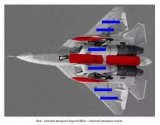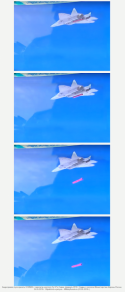Sorry, but increasing production of Su-57s to 9 per year in 2024???? ... really? that's about what CAC produces on J-20s per month and that's in 2023 almost the second or third year, in fact 9 per years is nothing!
It is nothing compared with that? Su-57 production rate is expected to reach maximum by current plan of 12 aircraft per year in like a couple of years. This is roughly similar to number of Rafale aircraft France produces. And unlike the case for France, Russia produces more jet fighter aircraft than just the Su-57. France only produces the Rafale and nothing else. The production plan has always been like this. Production of Su-57 will be minimal until the production facilities at the factory are upgraded and the Su-57M passes trials and enters serial production. They are building a new paint facility at the factory to apply the stealth coatings which was meant to the complete this year. Fact is, most of the Russian fighter air fleet is of pretty recent manufacture, so building more Su-57 of first production variant was not considered a priority by the RuAF.
And "~100 Su-35s" .... really? How many have been build so far overall? (as per a rough search I only found this: maiden flight in May 2011 ... In December 2018, UAC "has reported 100th serial Su-35S was produced at the Komsomolsk-on-Amur Aircraft Plant") so even under regular conditions, they produced only 100 between 2011 and 2018/19 and you think "producing a noticeable margin out of ~100 Su-35s doesn't take much time and effort."
Russia have more Su-35 aircraft than the amount of Eurofighters a country like Italy or Spain has. The total Su-35 order by the RuAF is roughly the amount of Eurofighters a country like the UK has. And the Europeans started producing those aircraft in the 1990s while Su-35 was introduced in 2010s. Plus Russia weren't just producing the Su-35, they also produced Su-30, Su-34, for RuAF plus export fighters. Just for the Flankers. If total aircraft factory production was devoted just for the RuAF they could have bought even more.
Most of the effect that sanctions could have had on the Russian defence industry was absorbed in 2014. People easily forget that Russia has not been sanctioned by the West for 1.5 years, but for a decade.
Correct.
When 2014 arrived, Russia was still almost totally dependent on the Ukrainian shipbuilding industry, in general it is clear that 2014 caught them by surprise once you look at all this kind of stuff. That is why the modernisation of surface ships stopped dead in its tracks; there were also Western technological inputs, as with the German gas turbines.
The core of your argument is correct, the sanctions did impact Russian naval shipbuilding of surface ships because of engine imports. But the Russians were importing gas turbines from Ukraine (used in the frigates), and from Germany they were importing diesel engines (used in the corvettes). They had to replace that with their own production. Where there is a dependence by Russia on German gas turbines it is in civilian applications like electric power generation. Not military applications.
This is one of the examples, but it is everywhere, including with another of the topics of special interest, such as semiconductors, in which the Russians have been making progress since 2014.
The Russians since 2014 have started serial production of: the N036 Belka GaA AESA radar, radar sensors used in their R-77-1 and R-37M air to air missiles, put the Elbrus-2SM processor into production at Mikron which is used in the Su-57. They started production of thermal sensors of both microbolometer and MCT thermal matrix type.
Backbone of RuAF are still Cold War, 80-s planes like Su-27, MiG-29, Su-24, Su-25, MiG-31.
Not true. Older Su-27s and MiG-29 have pretty much been retired. The ones still in service are mostly new build Su-27SM and MiG-29SMT types. That were built over last two decades. First Su-27SM was delivered in 2003 and the first MiG-29SMT was delivered in 2016. And those are available in limited numbers. Most aircraft in service are even more recent build Flanker types (Su-30, Su-34, Su-35). All in service MiG-31 aircraft are aircraft upgraded to MiG-31BM type. They replaced the electronics in those aircraft.
Russia had plans to upgrade several dozen Su-27P aircraft to Su-27SM3 status to save money but they ended up closing that program at like just 10 converted aircraft. Instead they decided to just order the Su-35. From what I know the Su-27SM/SM2 aircraft were built from stock parts available from China's cancelled Su-27SK order. So they used new build parts. The MiG-29SMT were also new builds from a cancelled Algerian order.
There is still a reasonably large stock of old Su-24 aircraft in use but those are mainly reconnaissance and electronic warfare variants for which there was no replacement yet. The ground attack type formations at this point have basically been been converted to the Su-34. And those Su-24s are expected to be replaced by in production Su-34NVO with external pods.
Some of them have been modernised, but all are about 35-40 years old now, and their replacement time was about 10 years ago, and I really doubt that Russia will be able to replace them in another 10 years, at least, and that's with 4-th generation, not 5-th...
...
So, it isn't new. And it will be older and older, especially now with the war and sanctions and who knows what will happen.
Russia built hundreds of heavy twin engine fighter aircraft since the Soviet Union collapsed. Their aircraft park isn't particularly old by any measure.
According to MiG managers they are capable of producing 40 Mig-35s a year.
Considering that part of the line should be destined for export, it makes sense to have a few Migs in the fleet, as they are much easier to maintain and less expensive, in missions like Syria, I think it is a better alternative.
I think they could do worse than produce some MiG-35s to replace the Su-25 as a ground attack type. The MiG-35 has a built in ground attack sensor OLS-K, has similar payload capacity as the Su-25, and can use modern standoff ground attack munitions. Once Ukraine's MiG-29s have been more attrited away it might become more viable to use the MiG-35 without it being mistakenly identified as a Ukrainian aircraft.


